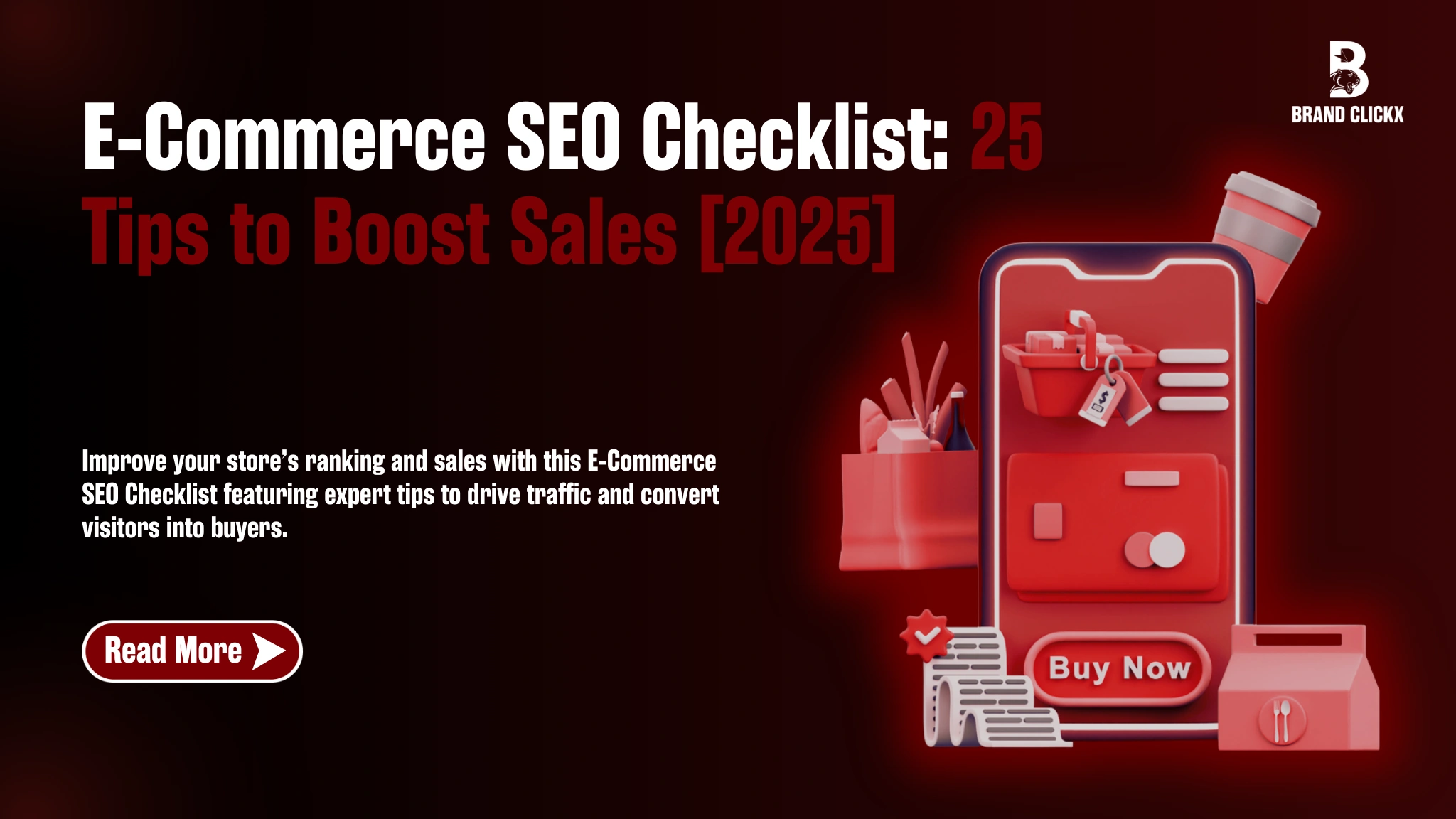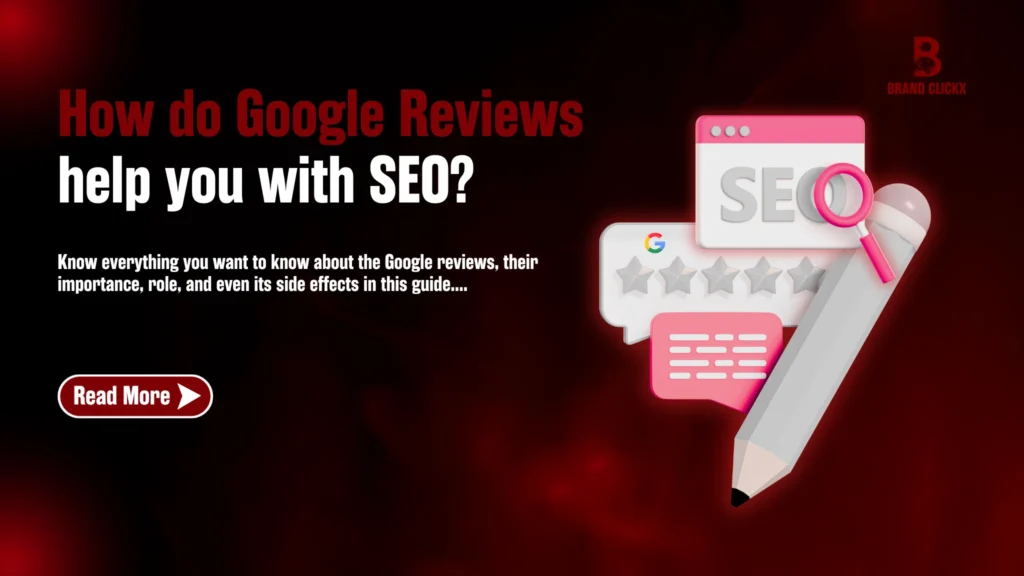Your e-commerce store is awesome. But if no one finds it, what’s the point? An effective e-commerce SEO strategy makes sure your products don’t stay hidden.
It’s not just about stuffing keywords. E-commerce SEO is about speed, trust, and giving people what they need fast. A slow, clunky site? That’s lost sales. Confusing product pages? Customers bounce.
This e-commerce SEO checklist keeps it simple. No fluff, just smart SEO moves that bring real results. Let’s get your store the attention it deserves.
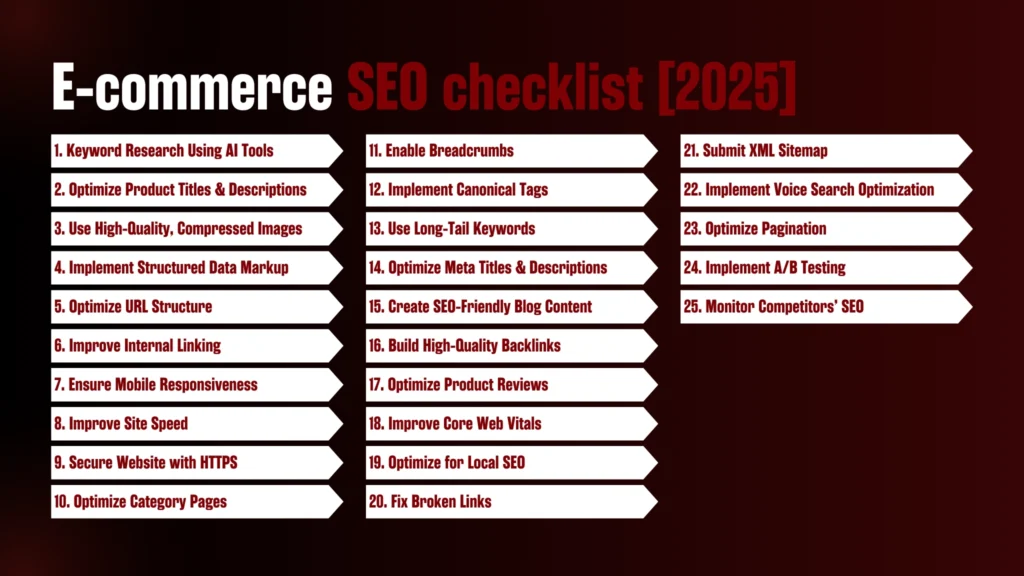
E-commerce SEO checklist [2025]
1. Keyword Research Using AI Tools
The first thing is knowing what your audience is searching for. AI tools like Semrush and Ahrefs make this easier. They suggest trending keywords and search intent. Pick words that match your products and customers’ needs.
Long-tail keywords really work well. They bring in people ready to buy. Instead of just “running shoes,” go for “best running shoes for flat feet.” Less competition, more conversions.
Also Read: Niche Keyword Research for Low-Competition Keywords in 2025
2. Optimize Product Titles and Descriptions
Your product title should be clear and direct. No need for fancy words; just be precise. Use primary keywords naturally, like “Wireless Noise Canceling Headphones 40hr Battery Life.” Plus, descriptions should answer customer questions.
3. Use High-Quality, Compressed Images with Alt Text
Shoppers buy with their eyes first. High-quality images build trust. But big images slow down your site, so compress them without losing quality. TinyPNG or ShortPixel can help.
Check out the images used to sell paintings on Etsy. They are clear, enticing, and beautifully presented in home settings. This helps showcase how they can enhance any space, making them more appealing to buyers.

Alt text is often ignored. But it helps SEO and accessibility. While writing alt texts, describe the image as if you’re explaining it to a friend. “Black leather wallet with RFID protection” is better than just “wallet.”
4. Implement Structured Data Markup (Schema)
Google loves clarity. To make your content easy to understand, use structured data. It helps search engines know exactly what your page is about.
This also improves rich snippets, showing details like price, stock status, and ratings directly in search results.
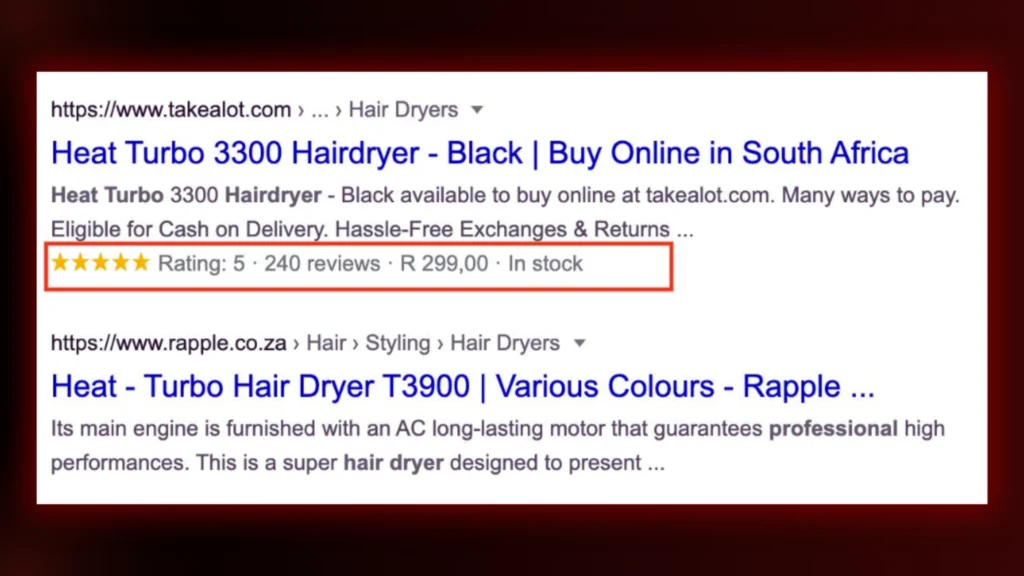
No coding is needed. Just use Google’s Structured Data Markup Helper. A few clicks, and your site is good to go!
Also Read: How to Leverage Schema Markup for SEO & Boost Visibility
5. Optimize URL Structure (Short, Keyword-Rich)
Keep URLs clean and readable. Avoid random numbers and symbols.
Instead of website.com/p12345?=productA
Use website.com/wireless-earbuds.
Shorter URLs are easier to share. Plus, they look more professional. If it’s too long, cut unnecessary words while keeping the keyword intact.

6. Improve Internal Linking Strategy
Guide users through your site. Link-related products and blog posts naturally. If someone’s looking at a laptop, suggest laptop bags or accessories.
Good internal linking helps SEO, too. It spreads link equity and keeps people engaged longer. Just don’t overdo it. Because too many links feel spammy.
7. Ensure Mobile Responsiveness
Most shoppers use their phones to search for the products they need. If your site isn’t mobile-friendly, you’re losing sales. Check how it looks on different devices. Buttons should be easy to tap, text should be readable, and images should load fast.
Google also ranks mobile-friendly sites higher. Use Google’s Mobile-Friendly Test to check yours. If something’s off, fix it before it costs you customers.

8. Improve Site Speed with Caching and Compression
Slow sites frustrate users. If your pages take forever to load, people leave. Compress images, enable browser caching, and use a fast hosting provider.
Tools like Google PageSpeed Insights or GTmetrix show what’s slowing you down. Fix those issues, and your site will feel smoother and faster.
9. Secure Website with HTTPS
Security isn’t optional. If your site isn’t HTTPS, Google warns users it’s unsafe. That alone can drive people away.
Get an SSL certificate—it’s often free with good hosting. It protects customer data and builds trust. A secure site also ranks better on search engines.
10. Optimize Category Pages for SEO
Category pages are more than just a list of products. Treat them like landing pages. Add a short, keyword-rich description at the top. Make it useful, not just stuffed with keywords.
For example, a category page for “Men’s Running Shoes” could mention:
- Top Brands
- Best Features
- Buying Tips.
This helps both users and search engines. The IKEA Category Pages, for instance, are great examples. Check out!
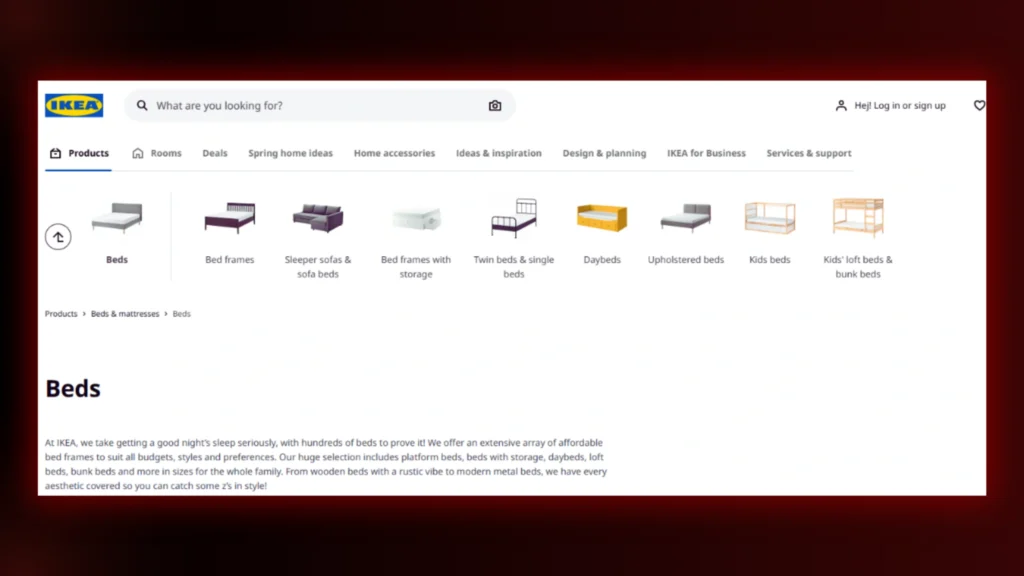
11. Enable Breadcrumbs for Better Navigation
Breadcrumbs show users where they are on your site. They also help Google understand your site structure. It’s a win-win.
For example, Home > Category > Running Shoes. Simple, clean, and useful. If you don’t have breadcrumbs, adding them is a quick SEO boost.

12. Implement Canonical Tags to Prevent Duplicate Content
E-commerce sites often have similar pages. If Google sees them as duplicates, it might not rank them well. That’s where canonical tags help.
A canonical tag helps Google know which page is the main one. If a product has multiple URLs, choose one as the preferred version. This prevents confusion and keeps your SEO strong.
13. Use Long-Tail Keywords in Product Pages
Broad keywords are tough to rank for. Long-tail keywords are more specific and convert better. Instead of using a “smartphone,” try the “best budget smartphone under $500.”
Think about how people search. They don’t just type “laptop.” They ask, “Which laptop is best for students?” Answer those questions in your content.
14. Optimize Meta Titles and Descriptions
Your meta title and description appear in search results. They need to be catchy but clear. Use keywords naturally, but don’t force them.
For example,
- Instead of “Best Running Shoes | Buy Now.”
- Try “Best Running Shoes for Comfort & Speed – Free Shipping!”
It’s engaging and gives a reason to click.
15. Submit XML Sitemap to Search Engines
A sitemap helps search engines crawl your site better. If you don’t have one, generate it using Yoast SEO (for WordPress) or an XML sitemap generator.
Submit it to Google Search Console. It’s a simple step, but it makes sure all your pages get indexed properly.
16. Build High-Quality Backlinks
Backlinks increase your site’s authority. But not all links are good. Focus on quality, not quantity. A few links from trusted sites are better than many from spammy ones.
Try guest blogging, influencer collaborations, or getting featured in industry publications. If your content is great, people will naturally link to it.
17. Optimize Product Reviews for SEO
Reviews build trust, but they also help SEO. Encourage customers to leave detailed reviews with keywords. “Great sound quality” is good, but “These noise-canceling headphones block out all background noise” is even better.
Use structured data so Google can show star ratings in search results. It makes your product stand out.
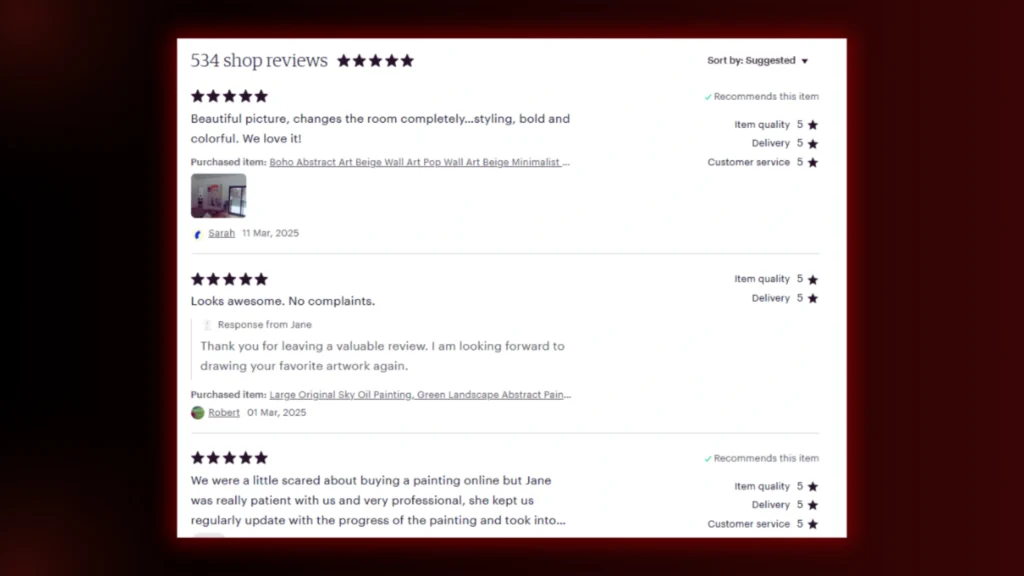
18. Improve Core Web Vitals Scores
Google now ranks sites based on user experience. Core Web Vitals measure things like loading speed, interactivity, and visual stability.
Check your scores in Google Search Console. If your site is slow or shifts while loading, fix it. A better experience means better rankings.
19. Optimize for Local SEO If Applicable
If you have a physical store, local SEO is a must. Claim your Google My Business listing. Make sure your name, address, and phone number are consistent everywhere.
Encourage happy customers to leave Google reviews. The more positive reviews, the higher you rank in local searches.
20. Monitor and Fix Broken Links
Nothing kills user experience like a dead link. Regularly check for broken links using tools like Screaming Frog or Ahrefs. Fix or redirect them ASAP.
A 404 page isn’t the end of the world, but a friendly one helps. Instead of “Page not found,” guide users back to useful pages.
21. Create SEO-Friendly Blog Content
A blog isn’t just for updates; it’s an SEO tool. Write useful guides, product comparisons, and how-to articles. Answer common questions customers have.
For example, Allbirds has a blog featuring topics like “Fall Shoe Trends” and “Outdoor Shoes for Nature Lovers.” These articles help educate users while subtly promoting products.

Likewise, if you sell skincare products, write about “Best Skincare Routine for Oily Skin.” People searching for that might end up buying your products.
22. Implement Voice Search Optimization
People search differently with voice. They ask full questions instead of typing keywords. Optimize for phrases like “Where can I buy affordable winter jackets?”
Write content in a natural, conversational tone. FAQs are great for this—answer questions about the way people speak.
23. Optimize Pagination for SEO
If you have lots of products, pagination helps. But it needs to be SEO-friendly. Use rel=”next” and rel=”prev” tags to show Google the right order.
Make sure pagination links are crawlable. Also, it allows users to view “All” products if possible, which improves their experience.
24. Implement A/B Testing for Conversion Optimization
SEO brings traffic, but what really matters is turning visitors into customers. A/B testing helps you figure out what works best. Try different product titles, descriptions, or layouts to see what gets more clicks and sales.
Tools like Google Optimize or Optimizely make testing simple. Even small changes, like a stronger call to action, can make a big difference.
25. Monitor Competitors’ SEO Strategies
Keep an eye on your competitors. What keywords are they ranking for? How do they structure their pages? Use tools like Ahrefs or Semrush to analyze them.
Learn from their wins and mistakes. If they’re doing something right, adapt it for your site, but do it better.
FAQs
1. How do you SEO an e-commerce website?
- Find Keywords – Use relevant, high-traffic keywords.
- Optimize Descriptions – Write unique, engaging product details.
- Improve Images – Use high-quality photos with alt text.
- Enhance Speed – Ensure fast loading and mobile-friendliness.
- Use Internal Links – Connect related products and pages.
- Fix Site Structure – Keep URLs and categories organized.
- Add Content – Write blogs or guides to attract traffic.
2. Which e-commerce platform is best for SEO?
There are various platforms, and the best choice depends on your needs. Some options include:
- Shopify – Easy, customizable, and SEO-friendly apps.
- WooCommerce – Great for WordPress users, strong SEO control.
- BigCommerce – Clean URLs and built-in SEO features.
- Magento – Highly flexible but needs technical skills.
3. How to Do Amazon SEO?
To do Amazon SEO:
- Use Keywords – Add them to titles and descriptions.
- Upload Quality Images – Follow Amazon’s guidelines.
- Get Reviews – Encourage positive feedback.
- Add Backend Keywords – Use hidden search terms.
- Price Competitively – Stay ahead of competitors.
- Use A+ Content – Improve visuals and descriptions.
Conclusion
E-commerce SEO isn’t about rankings; it’s about more clicks, customers and conversions. An optimised store gets the right traffic and keeps customers engaged. From fast-loading pages to keyword-rich product descriptions, every step on this checklist gets you closer to success.
But SEO isn’t a one-off. Trends change, algorithms update, and competition grows. Stay ahead by always improving your strategy. Test, tweak and track what works for your store.
Need expert help? Brand ClickX specializes in e-commerce SEO that drives real results. From keyword research to technical optimisation, we do it all. Let’s grow your store’s visibility and sales together.

